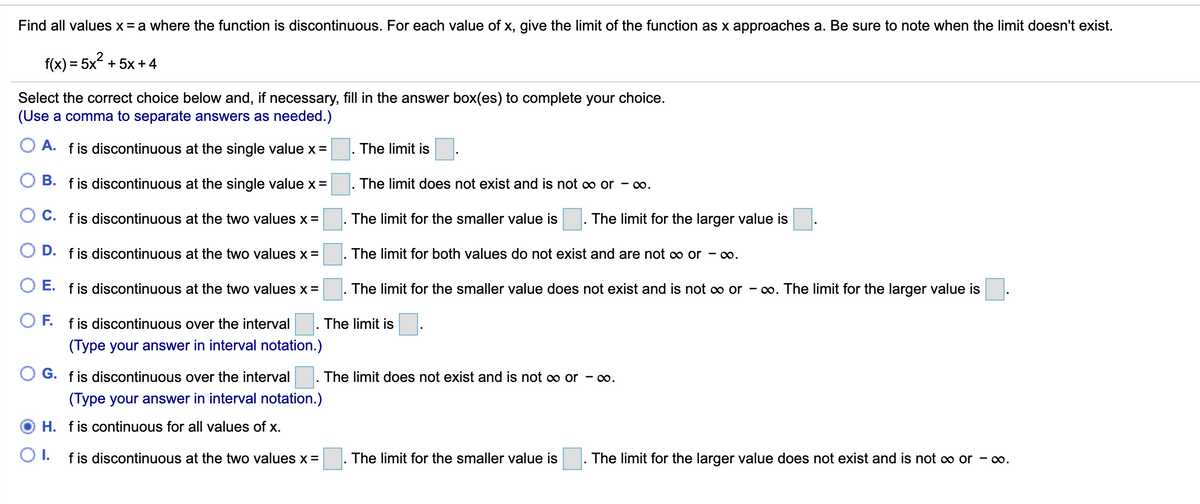Find all values x = a where the function is discontinuous. For each value of x, give the limit of the function as x approaches a. Be sure to note when the limit doesn't exist. f(x) = 5x² + 5x + 4 Select the correct choice below and, if necessary, fill in the answer box(es) to complete your choice. (Use a comma to separate answers as needed.) O A. fis discontinuous at the single value x= The limit is O B. fis discontinuous at the single value x = The limit does not exist and is not oo or - o. O C. fis discontinuous at the two values x= The limit for the smaller value is The limit for the larger value is O D. fis discontinuous at the two values x = The limit for both values do not exist and are not co or - o. O E. fis discontinuous at the two values x= The limit for the smaller value does not exist and is not o or - o. The limit for the larger value is O F. fis discontinuous over the interval . The limit is (Type your answer in interval notation.) O G. fis discontinuous over the interval The limit does not exist and is not oo or - 0o. (Type your answer in interval notation.) O H. fis continuous for all values of x. O1. fis discontinuous at the two values x= The limit for the smaller value is The limit for the larger value does not exist and is not o or - o.
Find all values x = a where the function is discontinuous. For each value of x, give the limit of the function as x approaches a. Be sure to note when the limit doesn't exist. f(x) = 5x² + 5x + 4 Select the correct choice below and, if necessary, fill in the answer box(es) to complete your choice. (Use a comma to separate answers as needed.) O A. fis discontinuous at the single value x= The limit is O B. fis discontinuous at the single value x = The limit does not exist and is not oo or - o. O C. fis discontinuous at the two values x= The limit for the smaller value is The limit for the larger value is O D. fis discontinuous at the two values x = The limit for both values do not exist and are not co or - o. O E. fis discontinuous at the two values x= The limit for the smaller value does not exist and is not o or - o. The limit for the larger value is O F. fis discontinuous over the interval . The limit is (Type your answer in interval notation.) O G. fis discontinuous over the interval The limit does not exist and is not oo or - 0o. (Type your answer in interval notation.) O H. fis continuous for all values of x. O1. fis discontinuous at the two values x= The limit for the smaller value is The limit for the larger value does not exist and is not o or - o.
Elementary Linear Algebra (MindTap Course List)
8th Edition
ISBN:9781305658004
Author:Ron Larson
Publisher:Ron Larson
Chapter7: Eigenvalues And Eigenvectors
Section7.4: Applications Of Eigenvalues And Eigenvectors
Problem 10E: Find the limit if it exists of Anx1 as n approaches infinity, where A=[02120], and x1=[aa]
Related questions
Question

Transcribed Image Text:Find all values x = a where the function is discontinuous. For each value of x, give the limit of the function as x approaches a. Be sure to note when the limit doesn't exist.
f(x) = 5x + 5x + 4
%3D
Select the correct choice below and, if necessary, fill in the answer box(es) to complete your choice.
(Use a comma to separate answers as needed.)
A. fis discontinuous at the single value x =
The limit is
B. fis discontinuous at the single value x =
The limit does not exist and is not ∞ or - o.
O C. fis discontinuous at the two values x =
The limit for the smaller value is
. The limit for the larger value is
O D.
f is discontinuous at the two values x =
The limit for both values do not exist and are not co or - o.
O E. fis discontinuous at the two values x =
The limit for the smaller value does not exist and is not o or - o. The limit for the larger value is
OF.
f is discontinuous over the interval
The limit is
(Type your answer in interval notation.)
G. fis discontinuous over the interval
The limit does not exist and is not ∞ or - o.
(Type your answer in interval notation.)
H. fis continuous for all values of x.
O1.
f is discontinuous at the two values x =
The limit for the smaller value is
The limit for the larger value does not exist and is not c∞ or - o.
Expert Solution
This question has been solved!
Explore an expertly crafted, step-by-step solution for a thorough understanding of key concepts.
This is a popular solution!
Trending now
This is a popular solution!
Step by step
Solved in 2 steps with 2 images

Knowledge Booster
Learn more about
Need a deep-dive on the concept behind this application? Look no further. Learn more about this topic, calculus and related others by exploring similar questions and additional content below.Recommended textbooks for you

Elementary Linear Algebra (MindTap Course List)
Algebra
ISBN:
9781305658004
Author:
Ron Larson
Publisher:
Cengage Learning

Elementary Linear Algebra (MindTap Course List)
Algebra
ISBN:
9781305658004
Author:
Ron Larson
Publisher:
Cengage Learning